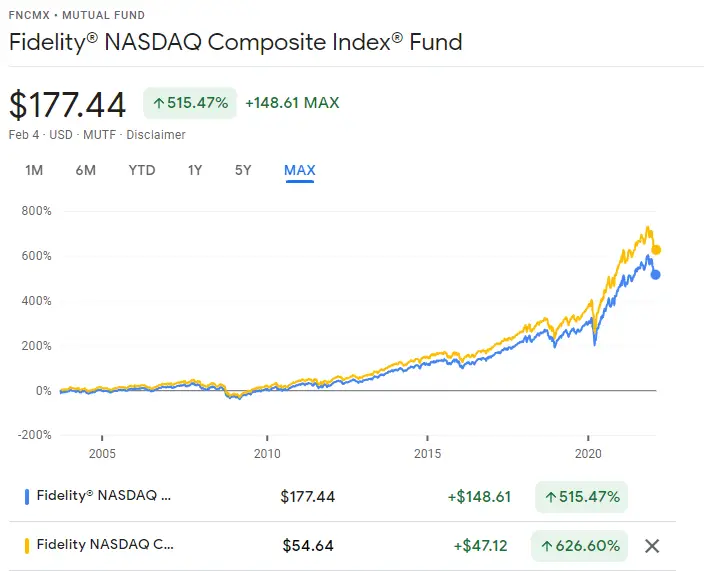Investing in stocks listed on the Nasdaq exchange is a good choice for investors who favor companies that have cutting-edge technology and products. Many companies from the Nasdaq Composite Index are involved in information technology and research and development. Examples include Apple, Microsoft, Nvidia, and Amazon.
QQQ is a popular tech ETF that tracks the Nasdaq-100 index. This index fund includes 90% of the stocks on the Nasdaq exchange (excluding financial companies).
FNCMX and ONEQ are two Fidelity Nasdaq Composite Index funds you can invest in if you want exposure to stocks listed on the Nasdaq exchange. They offer a bit more diversification than QQQ.
FNCMX vs ONEQ: What Are the Differences?
- Although they both track the same index, FNCMX is a mutual fund, while ONEQ is an ETF (exchanged traded fund).
- The expense ratio of FNCMX is 0.29%. The expense ratio of ONEQ is 0.21%. This means you save a little more when you use ONEQ.
- FNCMX pays dividends once a year (every December), whereas ONEQ pays dividends to shareholders every quarter. If the dividend distribution schedule is crucial to you, ONEQ would be a better fit.
- The Fidelity Nasdaq Composite mutual fund has more assets under management than its counterpart, 12.92 billion and 4.43 billion, respectively.
- The turnover rate of FNCMX is lower than ONEQ (by 12%). In other words, investors may see higher net returns and fewer costs from FNCMX.
FNCMX vs ONEQ: How Are They Similar?
- Both funds are from Fidelity, and they track the same underlying index: the Nasdaq Composite Index.
FNCMX vs ONEQ: Portfolio Composition
Because FNCMX and ONEQ invest at least 80% of its assets in stocks included in the Nasdaq index, they have similar holdings.
ONEQ Top 10 Holdings
| COMPANY | SYMBOL | TOTAL NET ASSETS |
|---|---|---|
| Apple Inc. | AAPL | 11.34% |
| Microsoft Corp. | MSFT | 9.83% |
| Amazon Inc. | AMZN | 6.58% |
| Tesla Inc. | TSLA | 4.12% |
| Alphabet Inc. Cl C | GOOG | 3.59% |
| Alphabet Inc. Cl A | GOOGL | 3.39% |
| Meta Platforms Inc. | FB | 3.12% |
| NVIDIA Corp. | NVDA | 2.85% |
| Broadcom Inc. | AVGO | 1.06% |
| Adobe Inc. | ADBE | 1.02 |
FNCMX Top 10 Holdings
| COMPANY | SYMBOL | TOTAL NET ASSETS |
|---|---|---|
| Apple Inc. | AAPL | 11.34% |
| Microsoft Corp. | MSFT | 9.83% |
| Amazon Inc. | AMZN | 6.58% |
| Tesla Inc. | TSLA | 4.13% |
| Alphabet Inc. Cl C | GOOG | 3.58% |
| Alphabet Inc. Cl A | GOOGL | 3.39% |
| Meta Platforms Inc. | FB | 3.10% |
| NVIDIA Corp. | NVDA | 2.86% |
| Broadcom Inc. | AVGO | 1.07% |
| Adobe Inc. | ADBE | 1.05% |
As of 12/31/2021
FNCMX vs ONEQ: Annual Return
| Funds | Fidelity® NASDAQ Composite Index® Fund | Fidelity® Nasdaq Composite Index® ETF |
|---|---|---|
| 1 month | -8.96% | -8.89% |
| 3 months | -7.89% | -7.66% |
| 6 months | -2.56% | -2.30% |
| 1 year | +9.73% | +10.16% |
| 3 years | +26.05% | +26.34% |
| 5 years | +21.40% | +21.57% |

Which is Better, FNCMX or ONEQ?
Under the hood, FNCMX and ONEQ are the same. Once you get past some minor differences such as expense ratio, turnover rate, and total net assets, you see that these two funds are extremely similar.
However, if I have to pick one, I would go with ONEQ and here’s why:
- In terms of expense ratio, ONEQ is cheaper than FNCMX.
- ONEQ is an ETF, which means it’s far more tax-efficient than a mutual fund like FNCMX.
- I prefer to receive my dividends on a quarterly basis. That way, I can reinvest them back into the fund more often.
Similar Comparisons
Community Comments:
Evan W:
ONEQ holds the entire Nasdaq, so I would keep that if you are looking for diversification into Mid/Small Caps. QQQ (or QQQM) just holds the top 100 companies, so you may prefer that if you want to have more concentration on the large caps.
Jason P:
100% of the companies in QQQ are in ONEQ. 10.8% of ONEQ’s holdings are in QQQ. And they have a 72% overlap by weight—no need to hold both.
I would switch to QQQM. It is the same as QQQ but with a lower expense ratio. Unless you need the volume to trade frequently, QQQM is cheaper, and both QQQ and QQQM outperform ONEQ.
1 post – 1 participant
